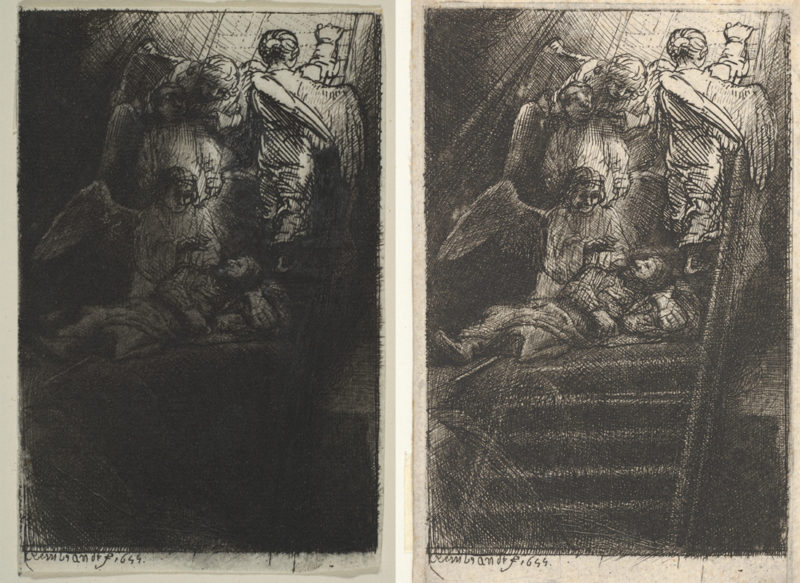 Rembrandt van Rijn, two impressions of Jacob’s Ladder, 1655, etching and drypoint, 4⅝” x 3⅛”, Collection of the Metropolitan Museum of Art, New York.
Rembrandt van Rijn, two impressions of Jacob’s Ladder, 1655, etching and drypoint, 4⅝” x 3⅛”, Collection of the Metropolitan Museum of Art, New York.
In printmaking, a burr is made of the metal that remains on a printing plate after it has been displaced in the process of carving an image. This often happens when using drypoint as a printmaking technique. When creating a print using the drypoint method, the artist scratches an image into a metal plate using a sharp instrument; the metal bits that stay attached to the surface is the burr. The burr then catches and holds extra ink during the process of printing, giving the image a soft and saturated appearance. Because the burr is made of tiny pieces of metal, the artist only is able to pull a relatively small amount of prints that display the softness of the burr before it has worn away.
Rembrandt van Rijn was a master of printmaking largely because he used the drypoint technique to its best advantage. In this comparison of two impressions of his print Jacob’s Ladder, you can see how different a print with a burr looks compared to one that was made from a plate that no longer has the burr.
On the left is the impression of Rembrandt’s print that had the burr. Velvety darks surround Jacob as he sleeps. The story in the Old Testament describes Jacob’s dream in which a ladder appears that stretches to the sky where he sees God who tells him about the destiny of his family and that he will be protected. The shroud of darkness provided by the burr accentuates by contrast the brightness of the vision and the message in the dream.
On the right is the print without the burr. While the fine illustration of the event remains, the tonal quality is lost, as is – arguably – some of the spiritual content.
 Rembrandt van Rijn, two impressions of Jacob’s Ladder, 1655, etching and drypoint, 4⅝” x 3⅛”, Collection of the Metropolitan Museum of Art, New York.
Rembrandt van Rijn, two impressions of Jacob’s Ladder, 1655, etching and drypoint, 4⅝” x 3⅛”, Collection of the Metropolitan Museum of Art, New York.
 Rembrandt van Rijn, two impressions of Jacob’s Ladder, 1655, etching and drypoint, 4⅝” x 3⅛”, Collection of the Metropolitan Museum of Art, New York.
Rembrandt van Rijn, two impressions of Jacob’s Ladder, 1655, etching and drypoint, 4⅝” x 3⅛”, Collection of the Metropolitan Museum of Art, New York.
